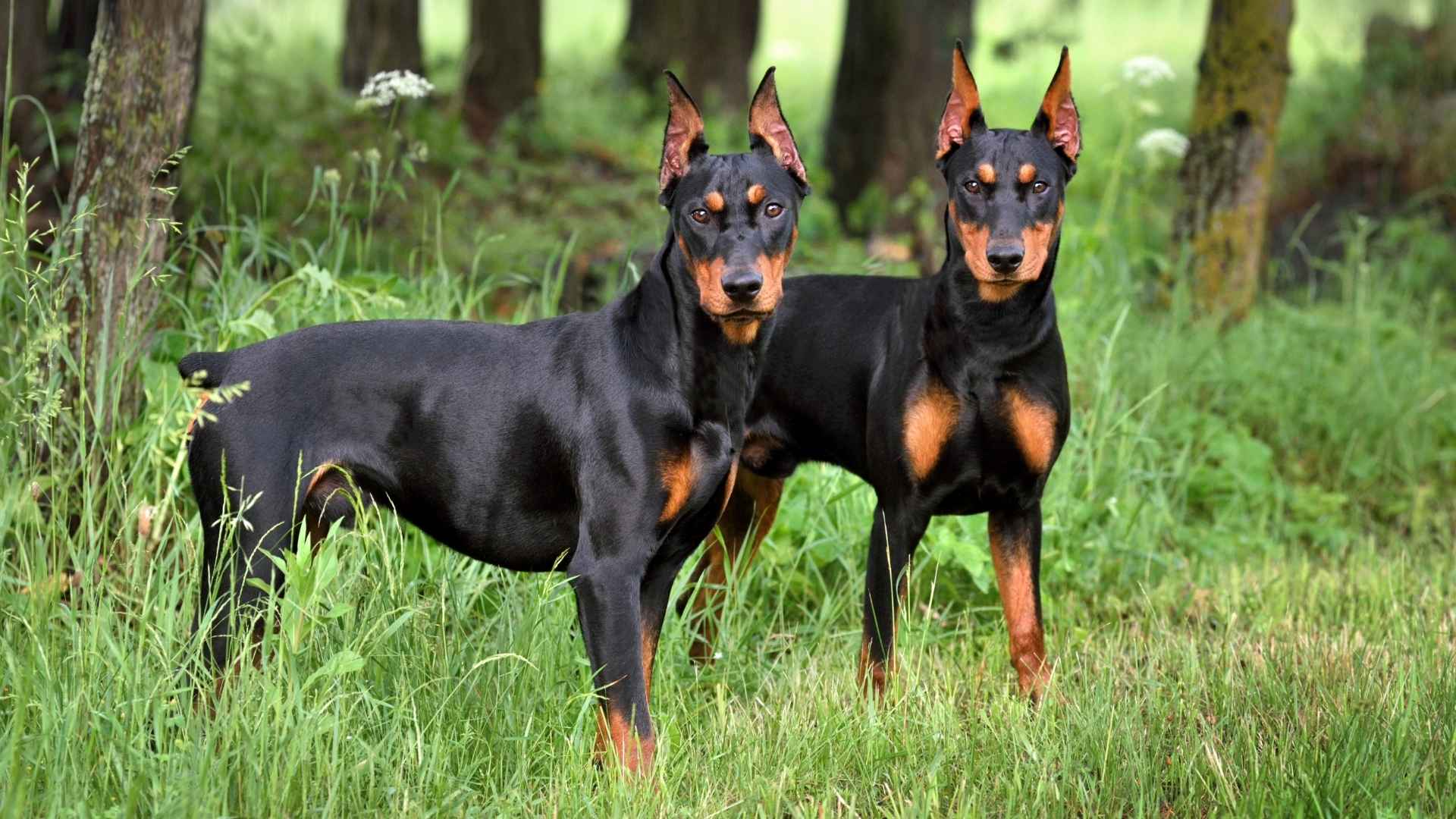Ever feel like your house could use a little extra protection, but with a tail and a loving heart? You’re not alone.
For centuries, humans have relied on dogs not just for companionship, but for serious, on-duty guarding. These breeds don’t just bark—they assess, alert, and if needed, defend with unwavering loyalty.
Whether it’s a Rottweiler standing watch like a stoic knight, or a Doberman zipping across the yard like a shadow with teeth, these popular guard dog breeds are in a league of their own.
But make no mistake—behind those sharp instincts is a soft heart for family. The key is finding the right breed: one that balances protectiveness with trainability, and affection with alertness.
We’re introducing you to the ultimate home-security squad—no wires or batteries required. From loyal German Shepherds to fearless Cane Corsos, these protective dog breeds mean business. And when it comes to protecting their pack (that’s you!), they don’t play around.
Common Guard Dog Breeds
1. German Shepherd
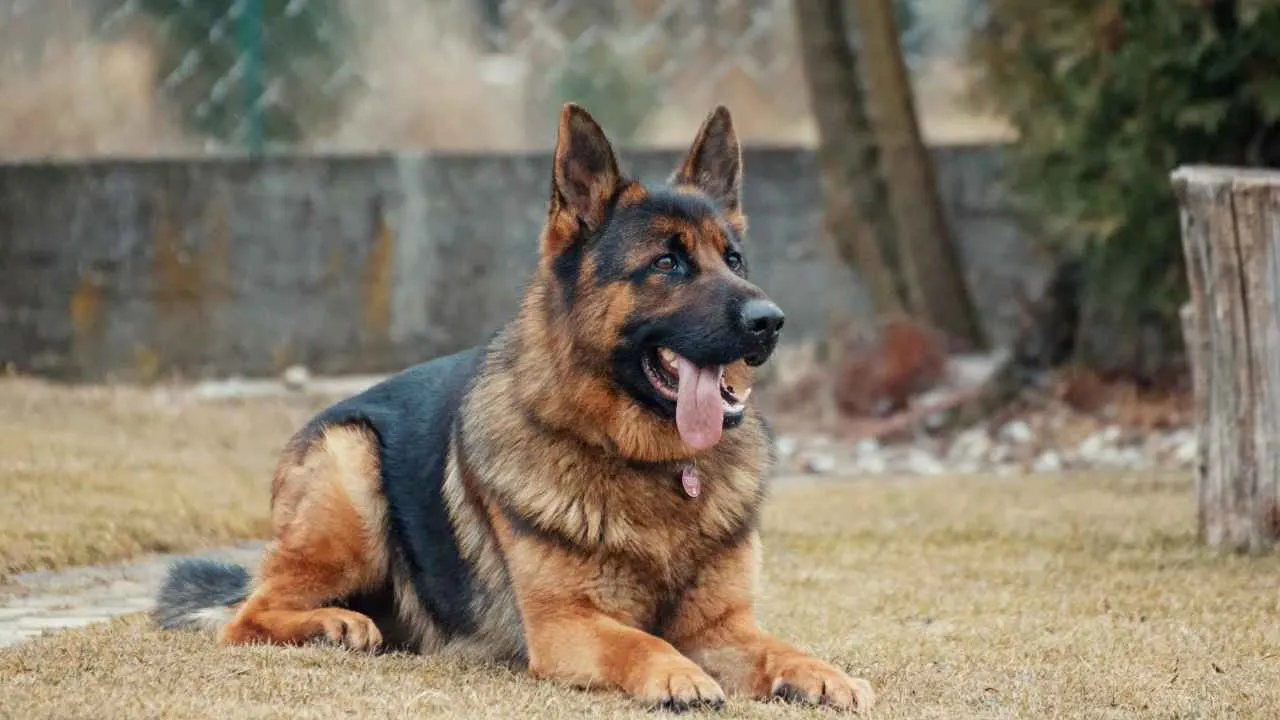
Breed Group: Herding Group
Loyal, intelligent, and born to work—the German Shepherd isn’t just a dog, it’s one of the most protective dog breeds on this planet. It’s a four-legged legend. Whether they’re herding sheep, sniffing out danger, or chasing tennis balls at warp speed, this breed is always on a mission. And usually, that mission is: protect the people, be the hero, get belly rubs.
Originally bred in Germany as herding dogs, German Shepherds quickly rose through the ranks to become the MVPs of the dog world.
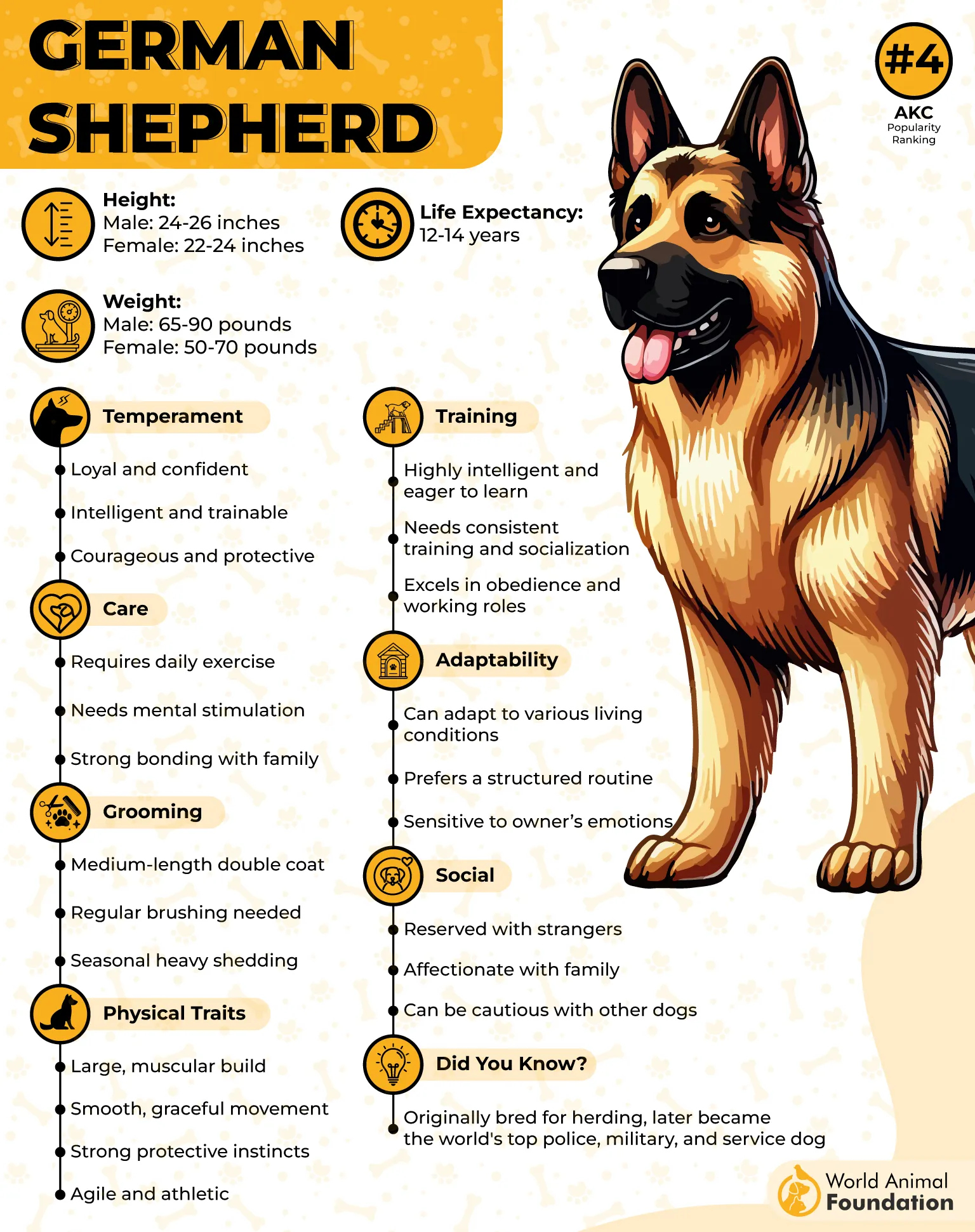
Need a police dog? Call a Shepherd. Search & rescue? They’re already packed. Executive protection? They’ll guard your family like royalty. Emotional support? They’re surprisingly sensitive under all that confidence.
German Shepherd Highlights:
Brainpower: Genius—often ranked in the top 3 smartest dog breeds
Guarding Style: Focused, fearless, and fiercely loyal
Best With: Active families, experienced owners, adventure lovers
With sharp minds and eager-to-please attitudes, German Shepherds are highly trainable and thrive on structure. Socialized well and trained early, they make fantastic family pets, especially for active households.
Just be warned: they need a job. A bored Shepherd will invent their own, which may involve redecorating your backyard or organizing your laundry into bite-sized pieces.
2. Rottweiler
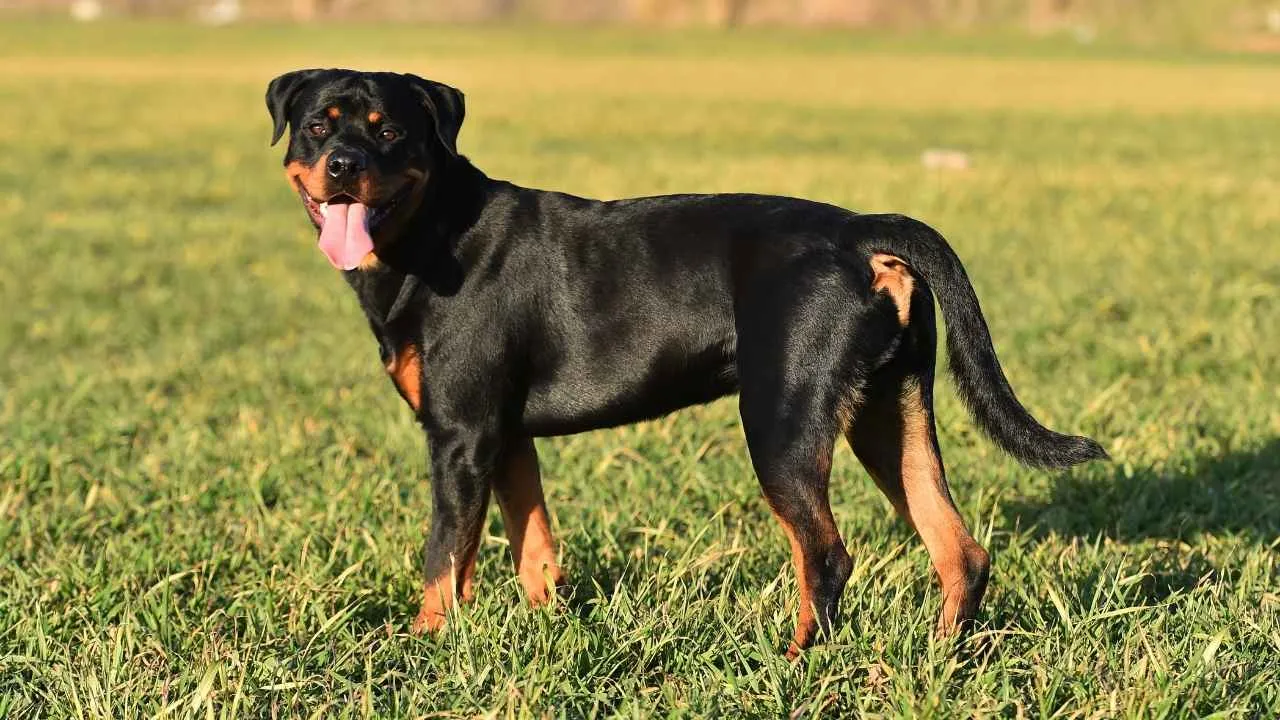
Breed Group: Working Group
Meet the Rottweiler—a broad-chested, block-headed blend of strength, smarts, and soulful loyalty. Affectionately called “Rotties” by fans and families alike, these large dogs are like the Swiss Army knives of the canine world: they guard, guide, work, cuddle, and conquer basic obedience training like pros—all with a side of drool.
Originally bred in ancient Rome to herd and protect livestock, Rottweilers traveled with soldiers and merchants, eventually becoming the trusted working dogs of German butchers and farmers.
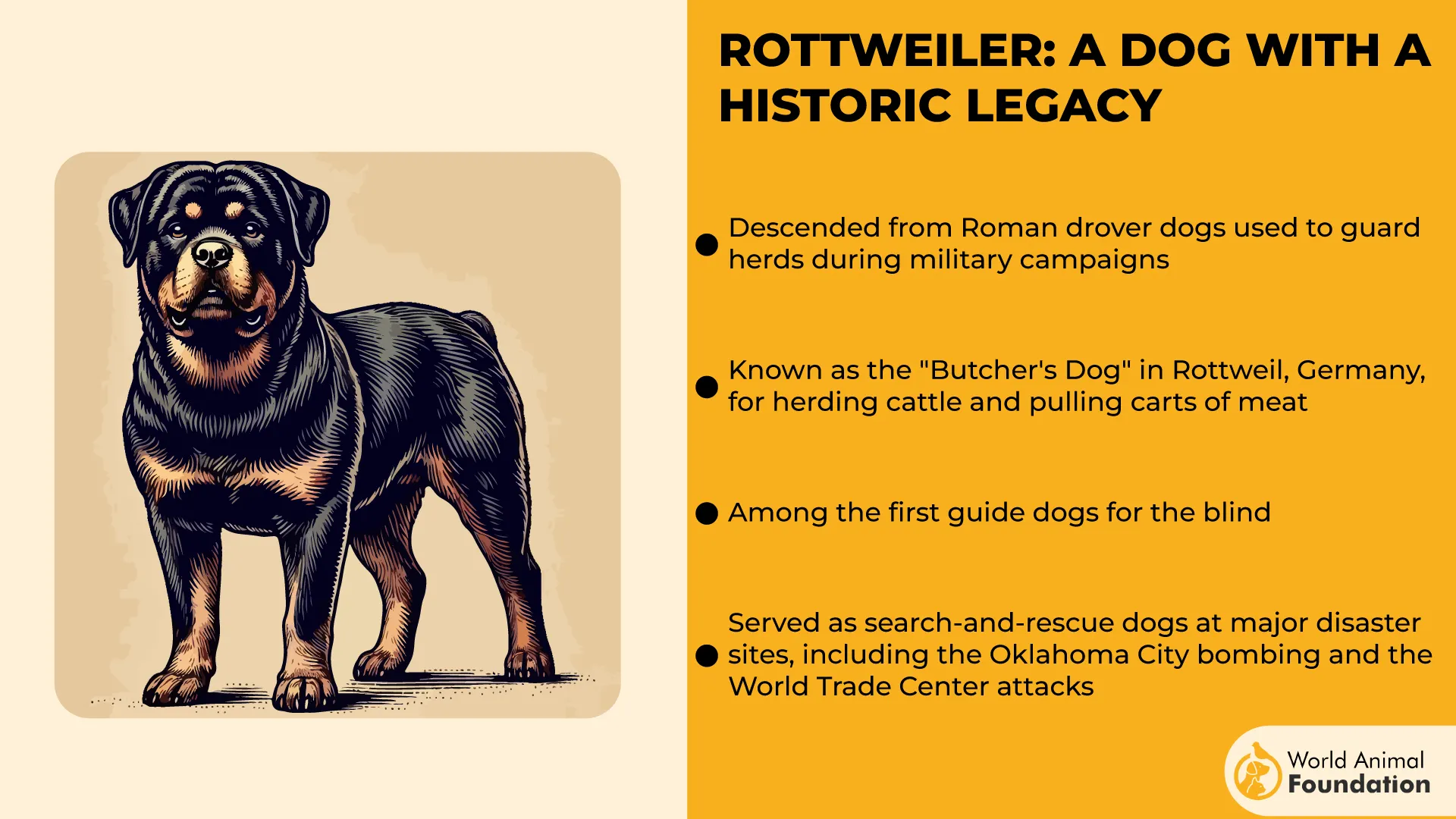
Fast-forward to today, and they’re doing everything from police work to therapy sessions, according to AKC. That’s right—this tough-looking dog has a gentle, emotional intelligence that surprises many.
Yes, they’re naturally protective and pack some serious power behind that calm demeanor—but they’re also goofy, affectionate, and downright devoted to their families.
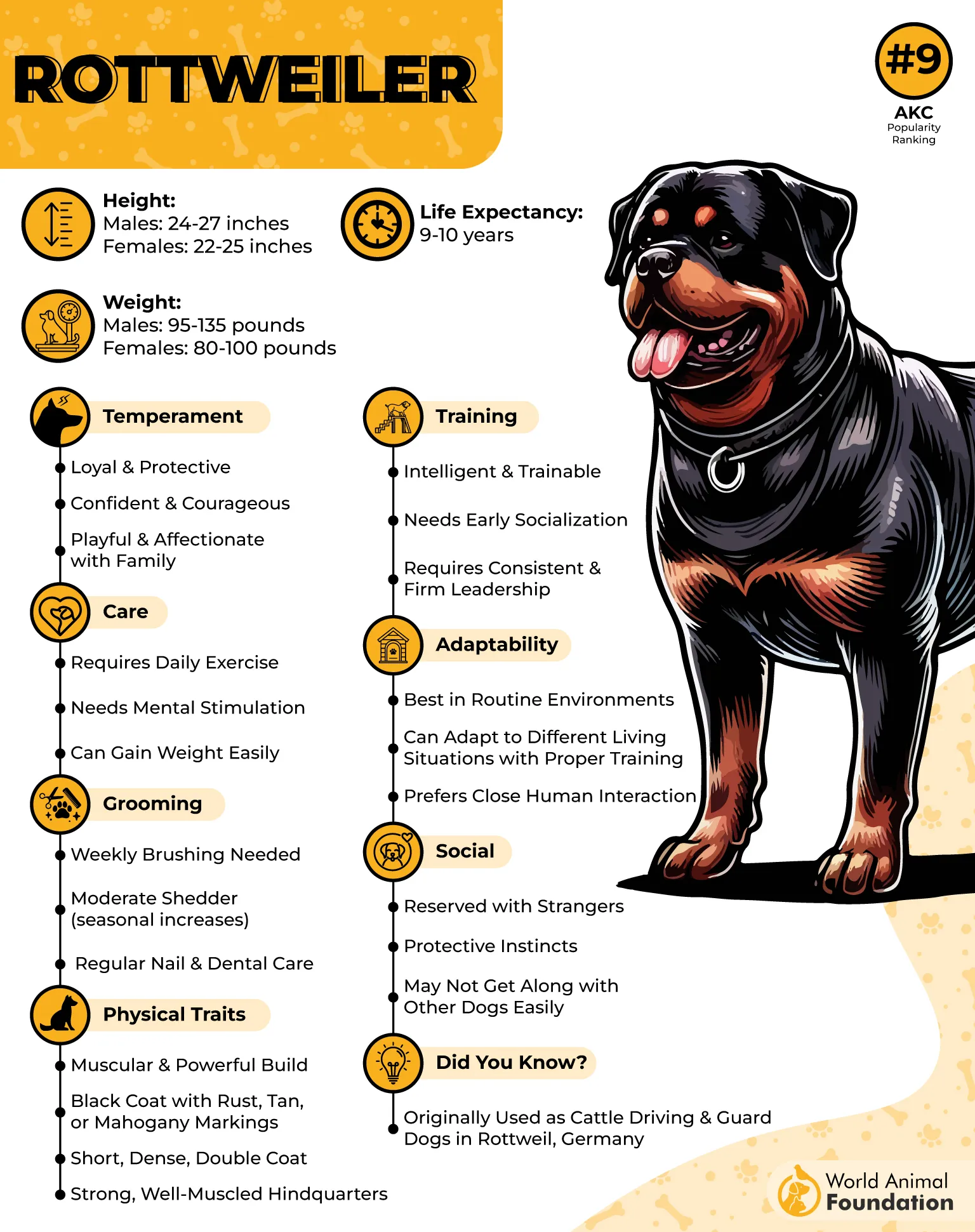
Rottweiler Rundown:
Vibe: Tough exterior, marshmallow interior
Brains: Highly intelligent dogs, eager to learn and please
Family Fit: Great with kids and owners who offer strong leadership
They crave structure, training, and a confident handler who understands their strength and sensitivity. Give them a purpose (and a comfy couch after patrol duty), and you’ve got a loyal guardian for life.
3. Doberman Pinscher
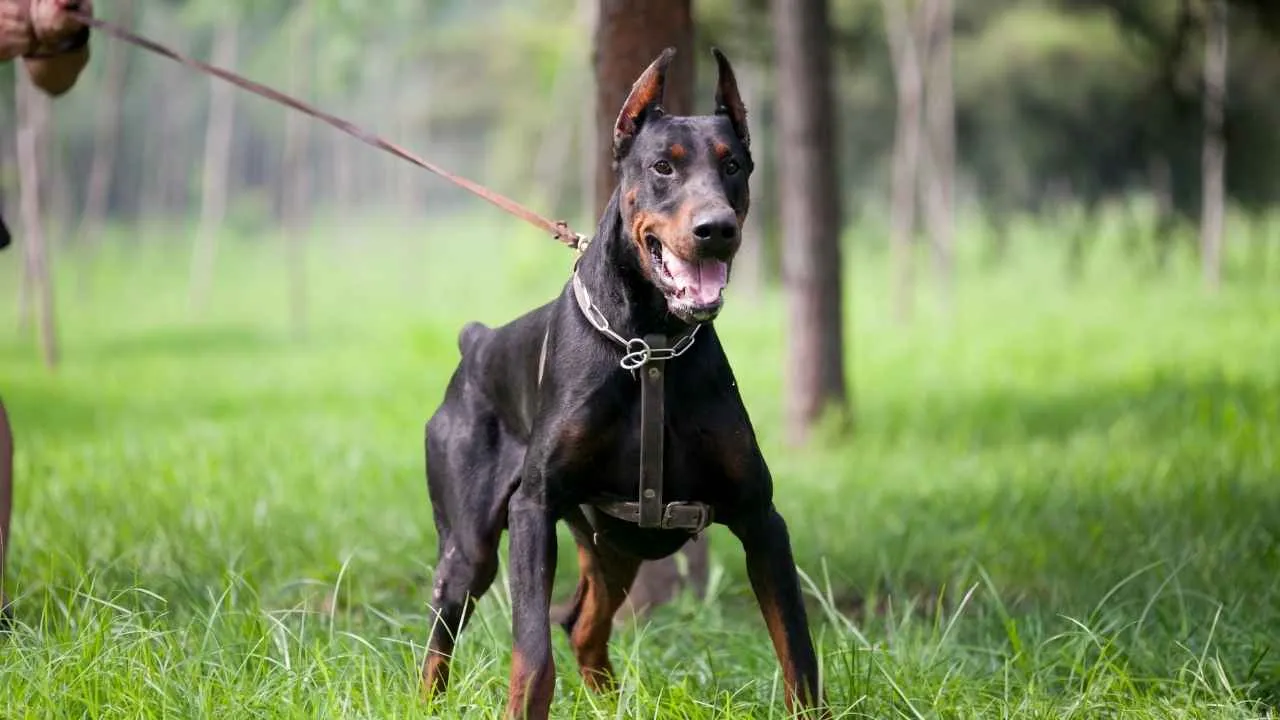
Breed Group: Working Group
Sleek, elegant, and built like an Olympic athlete in a tuxedo—meet the Doberman Pinscher, your stylish neighborhood protector. With a body sculpted like it’s ready for action and a brain that runs on high-speed Wi-Fi, the Dobie is as smart as they are striking.
Originally developed in 19th-century Germany by a tax collector (who clearly needed backup), this breed was designed to be fearless, loyal, and incredibly alert. Today, they serve in military and police roles, but they’re just as comfortable patrolling your home and loving your family like it’s their full-time job.
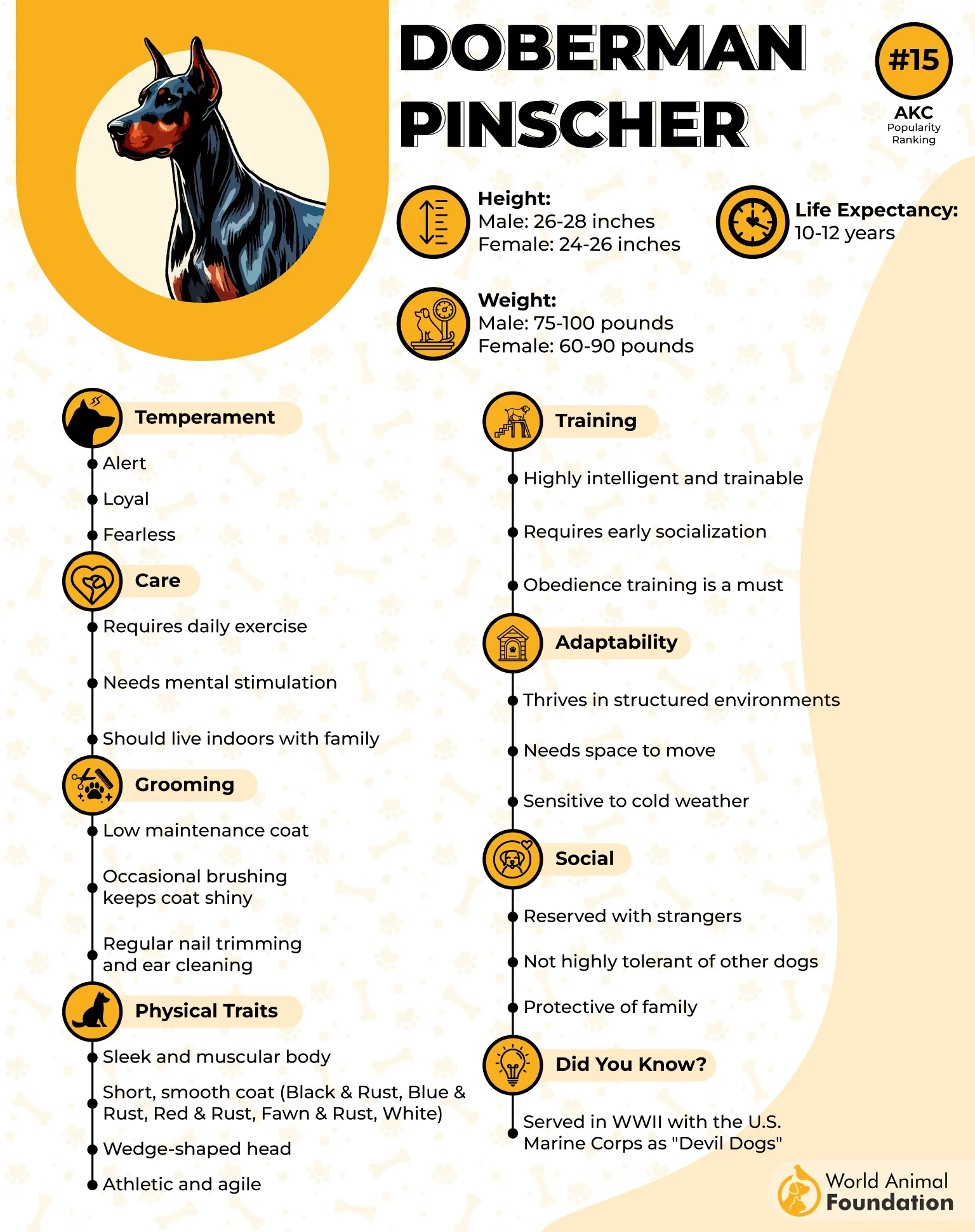
The Doberman is incredibly affectionate with its people and deeply devoted—they don’t just guard your home, these effective guard dog breeds guard your heart.
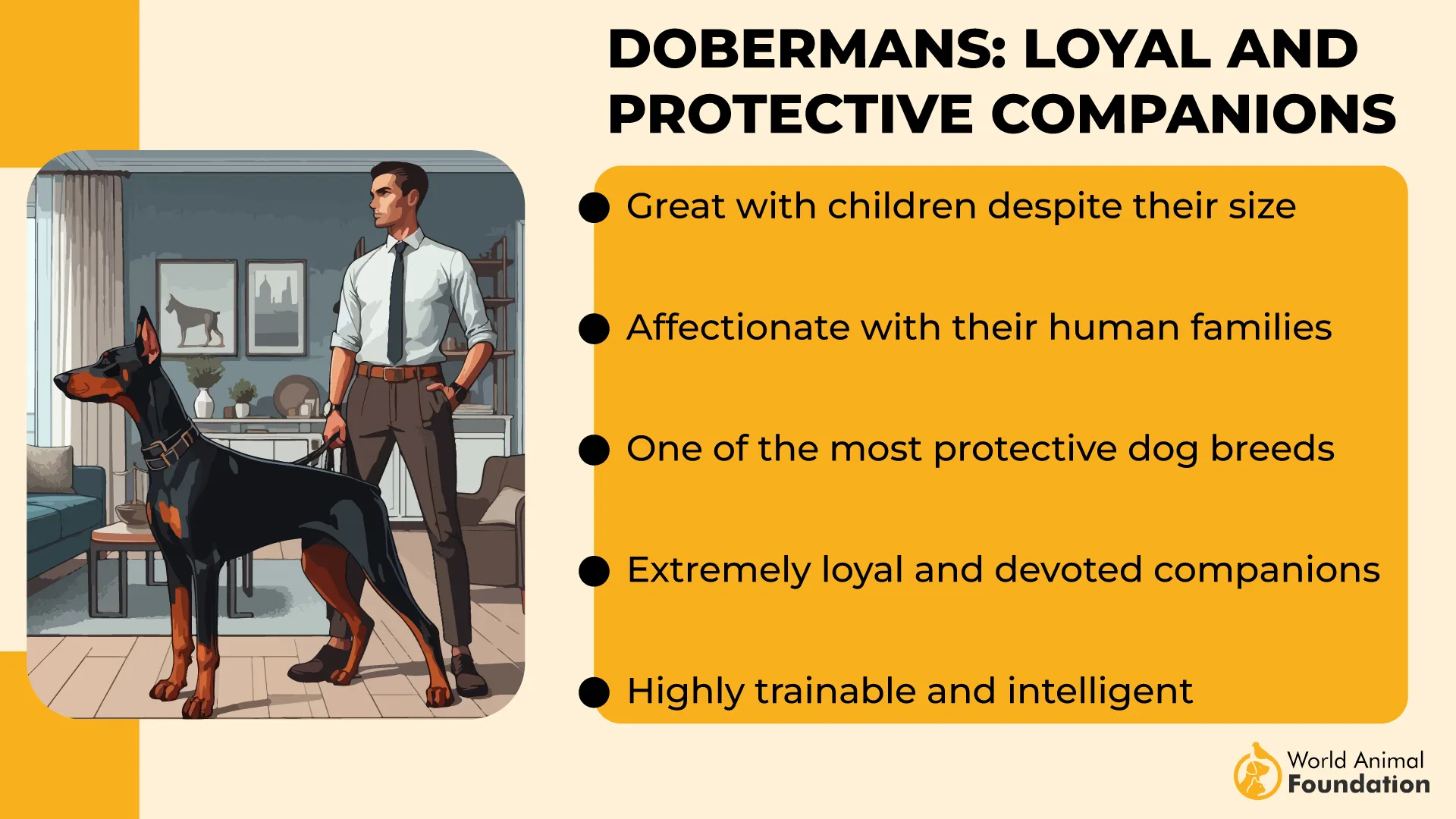
But make no mistake: with strangers, they’ll go from couch snuggler to security chief in half a second. Their speed, power, and sheer confidence make them one of the most effective personal protection dogs in the world.
Doberman at a Glance:
Intelligence: Top-tier—can learn faster than some humans
Protectiveness: Very high—born to guard, wired to love
Best For: Active, experienced owners with time and leadership
They do best with experienced owners who understand training, structure, and the need for daily mental and physical challenges. A bored Dobie is a Dobie with a hobby—and that usually means rearranging your furniture or digging for gold in your backyard.
4. Bullmastiff
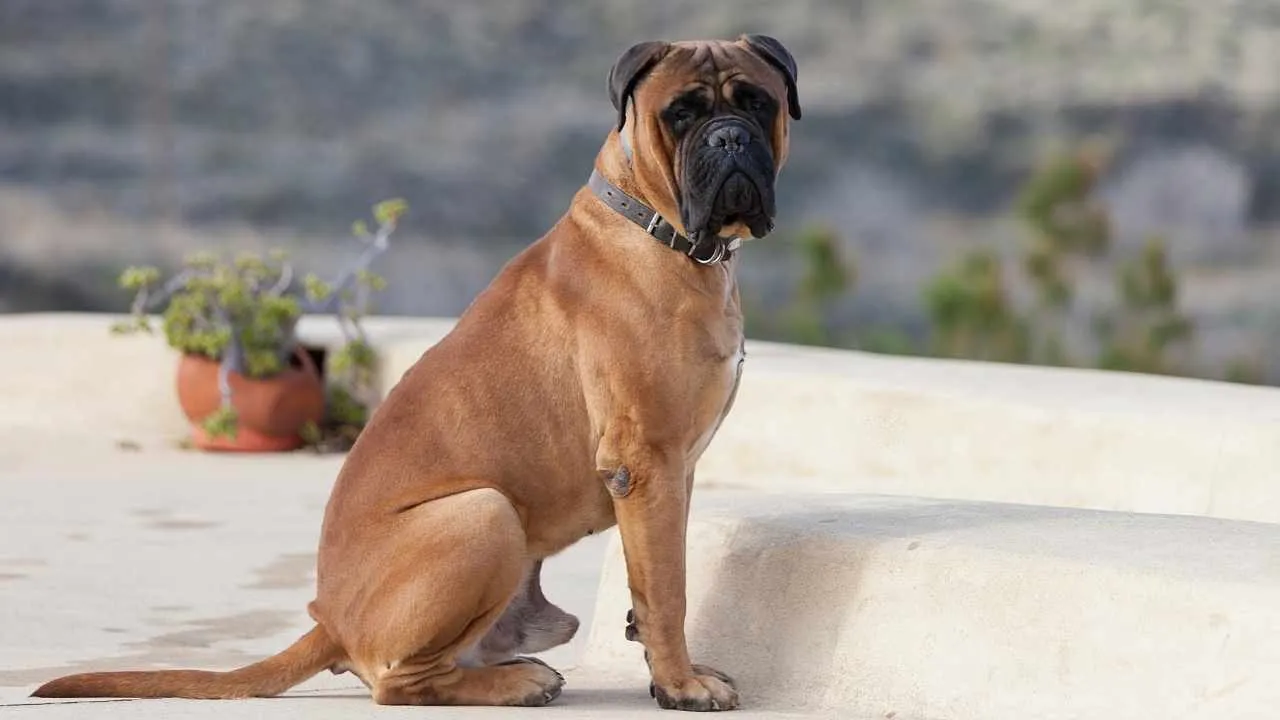
Breed Group: Working Group
Another best guard dog breeds on our list is the Bullmastiff. With their massive build, soulful eyes, and calm temperament, Bullmastiffs are both formidable protectors and mellow family snuggle buddies.
Originally bred in 19th-century England to catch poachers (but without biting them—just a polite full-body tackle), these giant breeds are the silent sentinels of the guard dog world.
They’re known for moving stealthily, barking only when absolutely necessary, and using sheer size and presence to intimidate intruders into rethinking life choices.
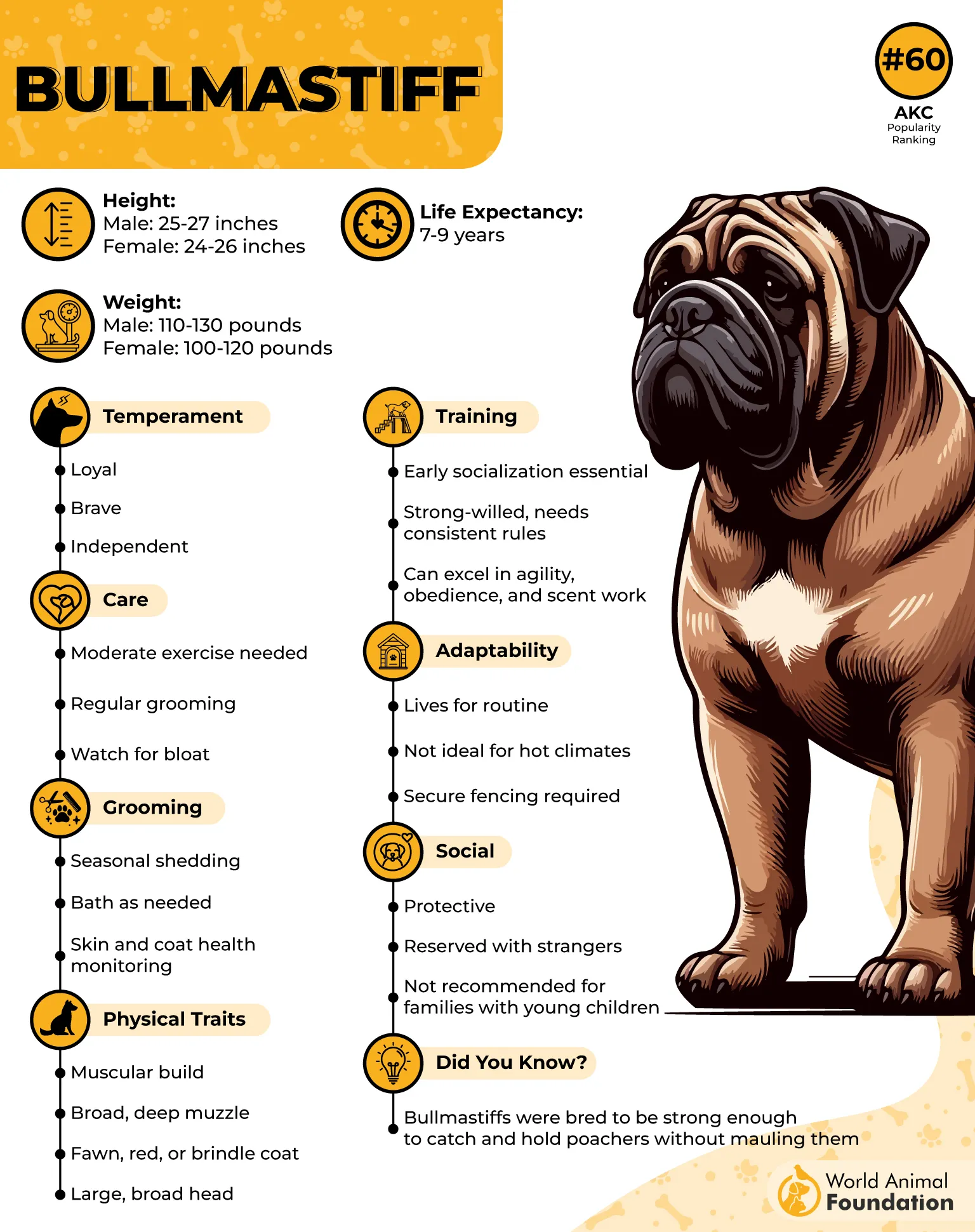
Standing 24–27 inches tall and often weighing over 120 pounds, the Bullmastiff is all muscle, all heart. They’re fiercely loyal dogs and have strong protective instincts, especially of children, and they form deep bonds with their families. But don’t expect high-speed zoomies—this dog’s speed bursts are reserved for threats, not squirrels.
Bullmastiff Breakdown:
Bark Level: Low – they prefer to sneak up like pros
Trainability: Steady and smart, but can be stubborn
Guard Instincts: Top-tier deterrent – no need for signs when you’ve got this dog
They don’t need hours of regular exercise, but mental stimulation and consistent training are key. And while they may not be the easiest breed for first-time owners, they make excellent guardians for confident, loving households.
5. Belgian Malinois
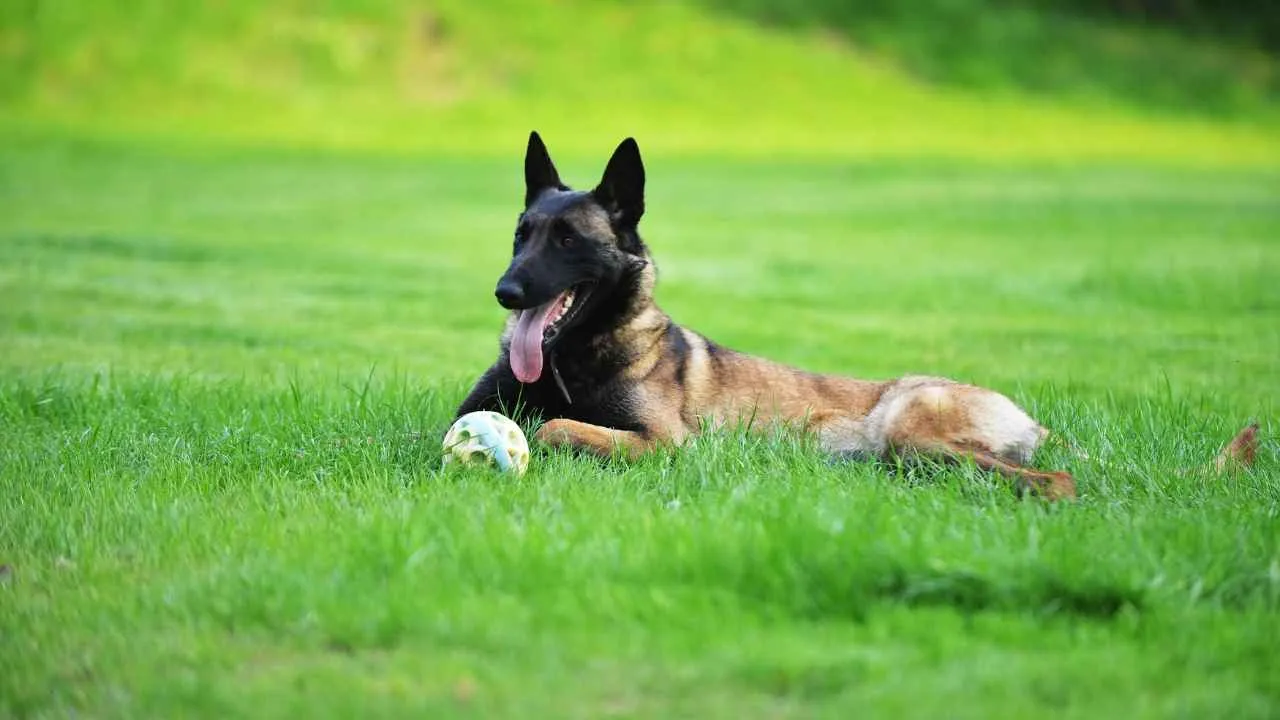
Breed Group: Herding Group
Looking for a dog that can skydive, track a scent for miles, and still be ready to go for a jog afterward? Meet the Belgian Malinois—the ultimate working dog with speed, smarts, and laser-sharp focus.
You’ve probably seen them working alongside Navy SEALs, on police K9 units, or starring in high-octane action movies. Yep, this breed is basically the Tom Cruise of the dog world: agile, intense, and always mission-ready.
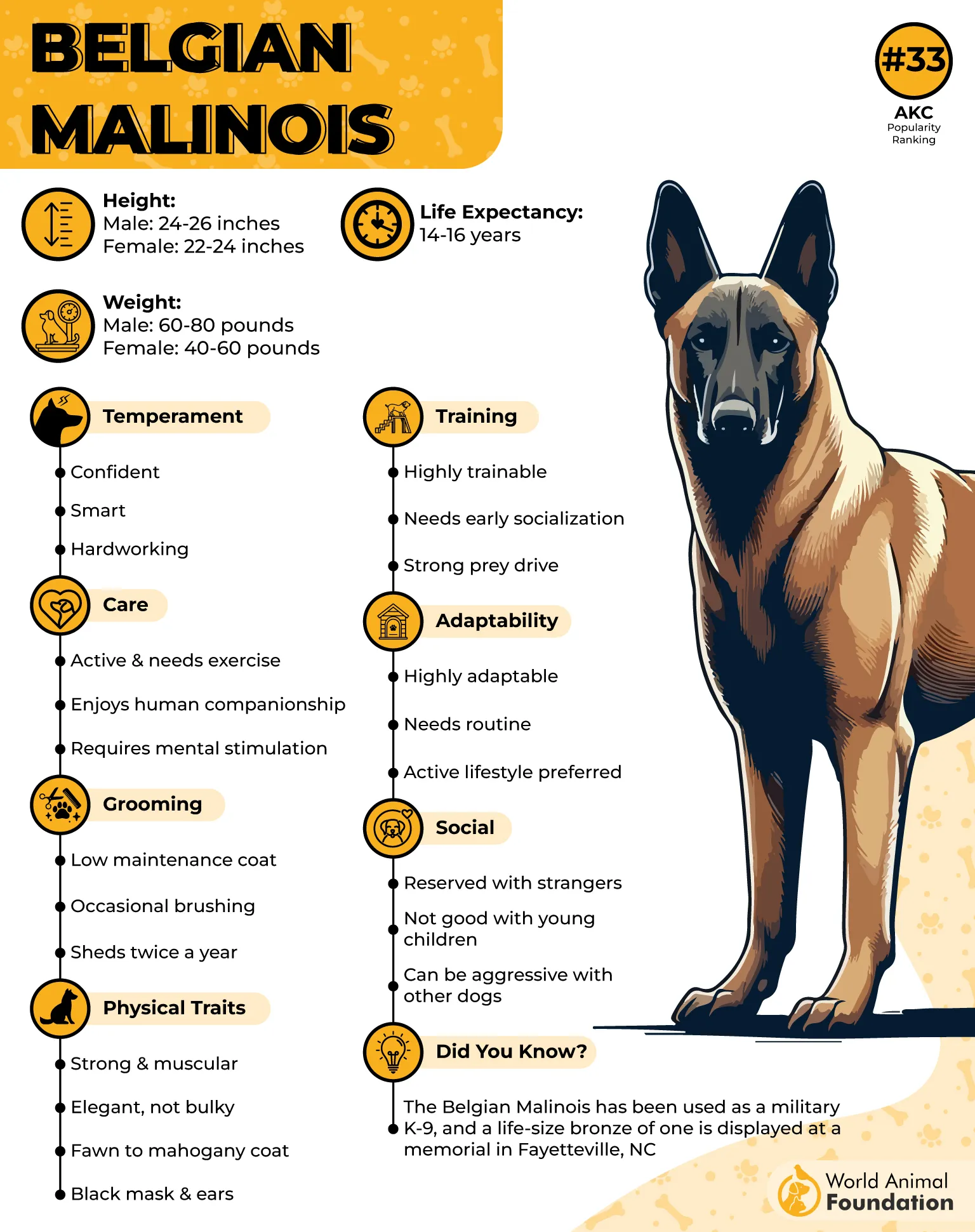
A member of the herding group, the Malinois was bred to manage livestock but quickly proved to be one of the most versatile, trainable, and alert breeds on the planet. With a lean, muscular body and a mind that never stops working, this is a dog that needs a job—or they’ll make one (like redecorating your couch).
Malinois Must-Knows:
Brainpower: Genius level (they’ll probably hack your Wi-Fi)
Energy Level: Endless—requires serious exercise and tasks
Best For: Active individuals, handlers, working dog programs
They’re loyal, protective, and deeply bonded with their handlers—but they’re not couch potatoes or beginner-friendly pups. Malinois need daily mental challenges, physical activity, and a confident leader. If you can meet their intensity, they’ll be your ride-or-die for life.
6. Staffordshire Bull Terrier
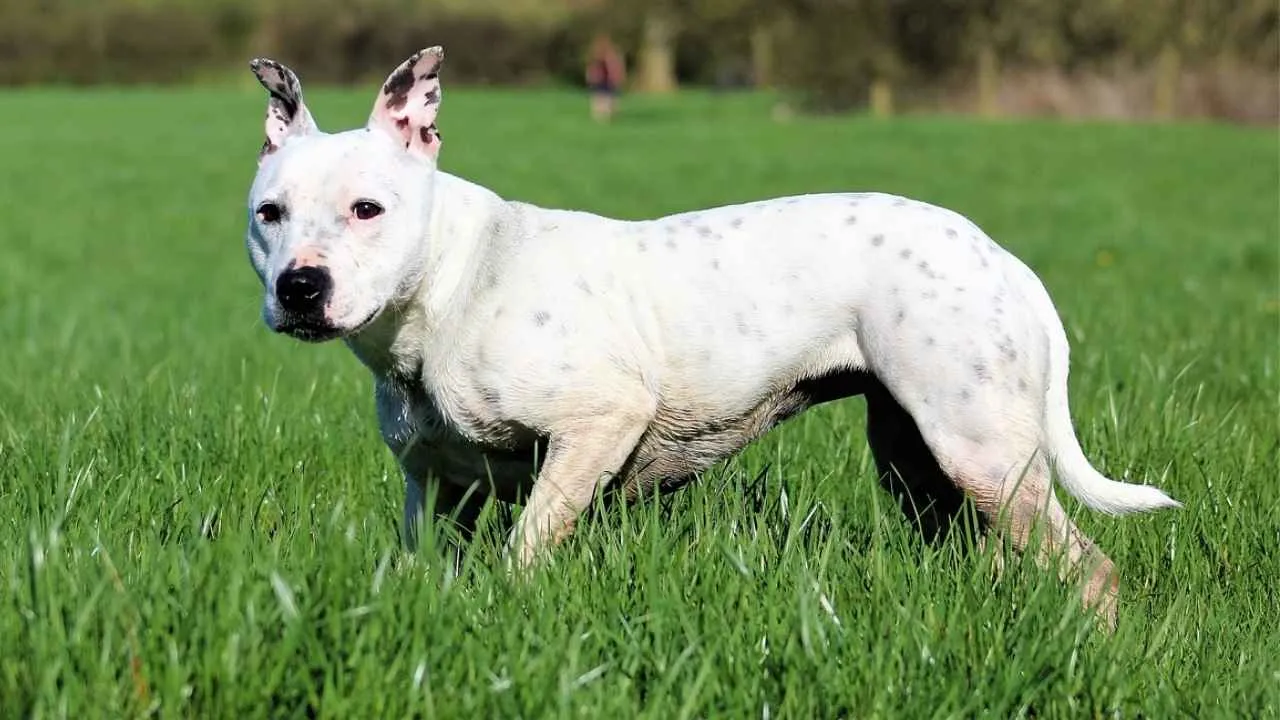
Breed Group: Terrier Group
Don’t let the compact size fool you—Staffordshire Bull Terriers are like dense little tanks made of muscle, love, and boundless determination.
Originally bred in England from Bulldogs and various terriers, they were once used for blood sports (thankfully long gone)—but today? They’re most famous for their affectionate, people-loving nature.
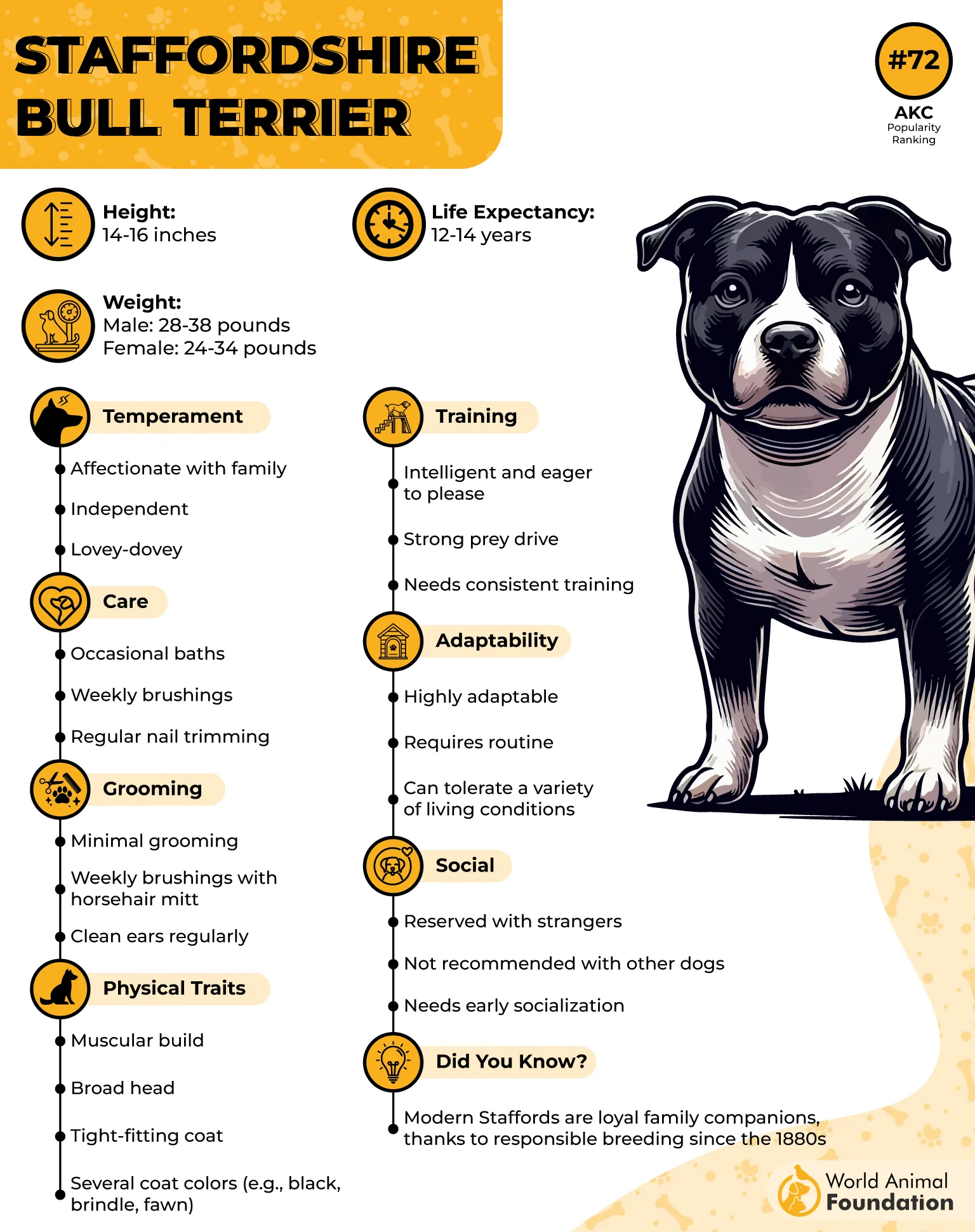
Known as the “nanny dog” in the UK, the Staffy adores children and becomes deeply bonded with its family. Just imagine a bodybuilder who also happens to be a babysitter—that’s the vibe. They’ll protect your home if needed, but most of the time, they’re more interested in cuddling under the covers and being wherever you are.
Staffy Stats:
Personality: Loving, tenacious, fearless (but not aggressive)
Exercise Level: High—zoomies included
Guard Ability: More protective than they look, with a surprising bark
Yes, they’re strong-willed and bursting with energy, so early training and consistent boundaries are key. But give them structure, affection, and some space to zoom around, and they’ll repay you with years of loyal companionship.
7. Cane Corso
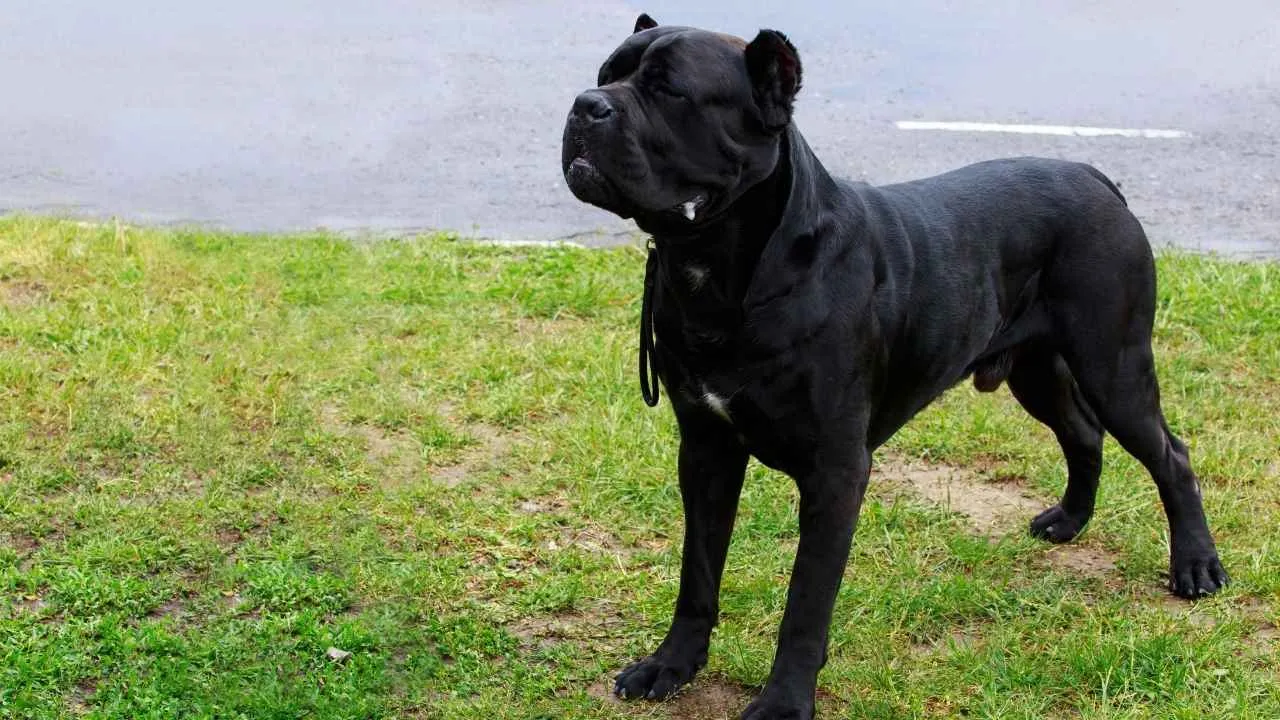
Breed Group: Working Group
If gladiators had a canine sidekick, it would’ve been the Cane Corso—a muscular mastiff with ancient war dog roots and a presence that says, “You shall not pass.”
Born from the legendary Molossian dogs of ancient Rome, the Cane Corso once marched into battle alongside soldiers and later worked as a fearless guardian of Italian farms. Basically, this breed was built to protect, serve, and look absolutely majestic while doing it.
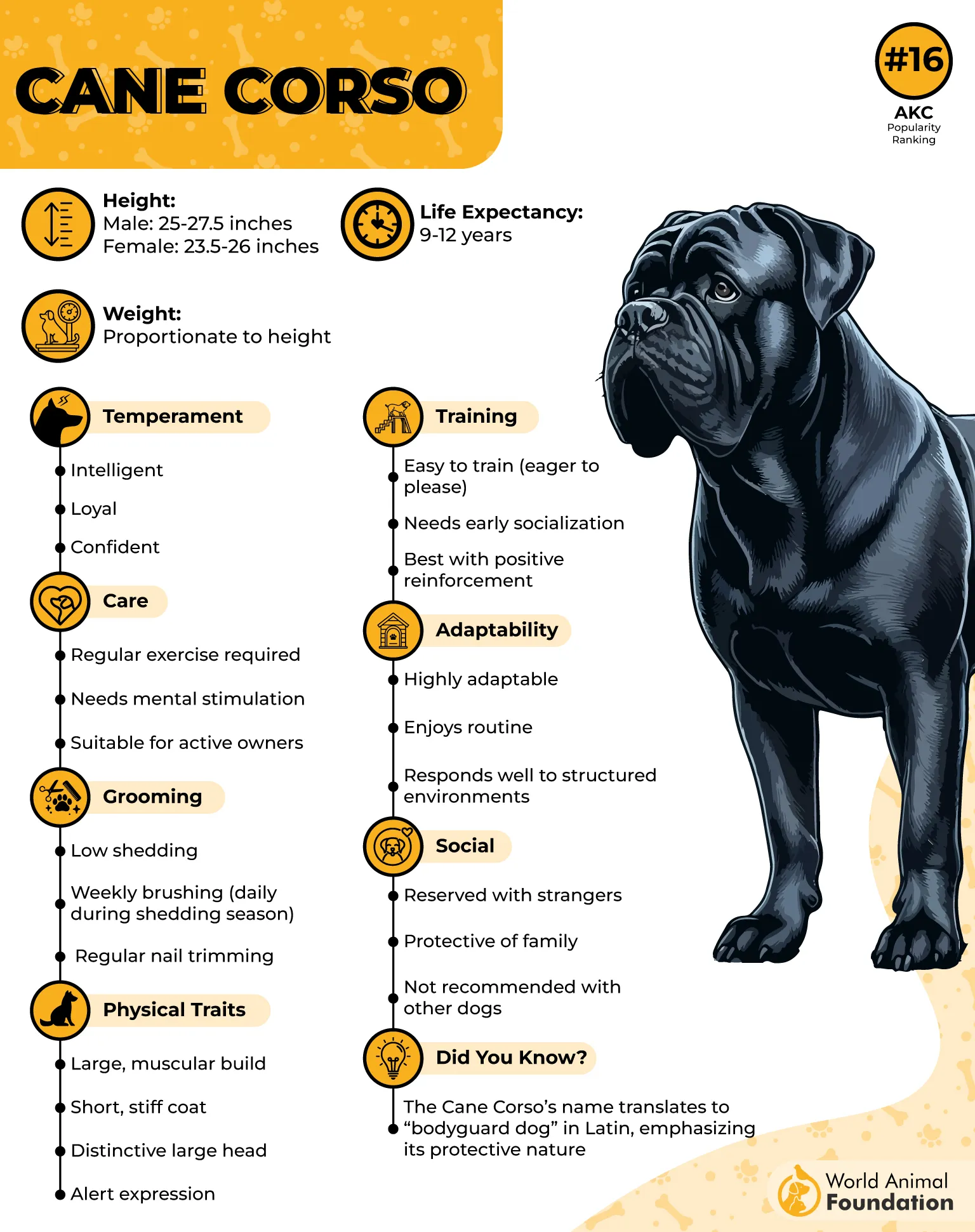
The name “Cane Corso” literally means “bodyguard dog,” and they take the title seriously. With a massive frame, watchful eyes, and a deep, bone-rattling bark, they’re not the type to roll over for strangers. Suspicious by default, the Corso needs early, thorough, proper socialization to avoid going full medieval on every new guest at your barbecue.
According to Britannica, the Cane Corso makes an outstanding watchdog and, with proper training, can serve well as a protection dog. While it tends to be relatively independent, it ranks around average when it comes to trainability. This breed is loving toward its family but has a naturally serious demeanor.
Cane Corso Quickfire:
Personality: Serious, loyal, a touch dramatic
Strength Level: Leash? What leash?
Best With: Experienced handlers, structured homes
Think of them like your tough Italian uncle who’s stoic in public but secretly spoils the grandkids. Just don’t expect clown behavior or puppy-like charm. This breed is all business with a soft emotional undercoat.
8. Boxer
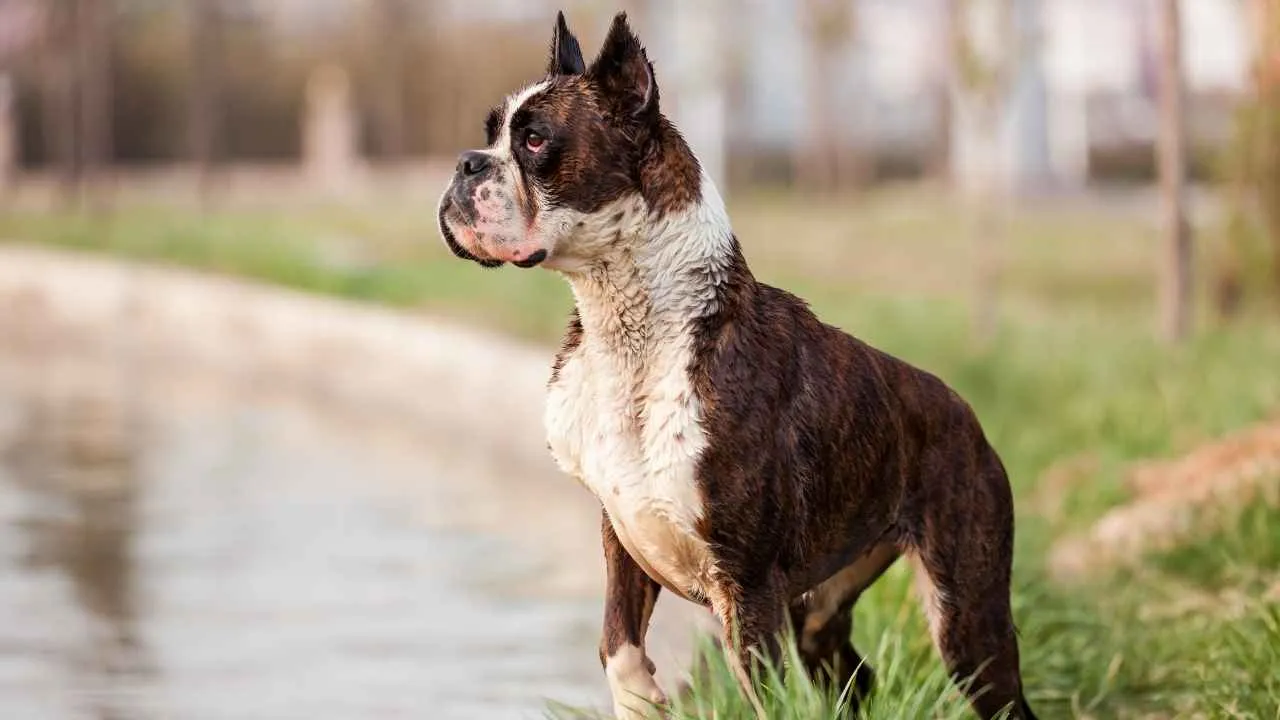
Breed Group: Working Group
Meet the Boxer—the only guard dog that might try to wiggle you into submission before protecting you from danger.
With a name like “Boxer,” you might expect a tough, no-nonsense fighter. And while this breed can throw paws with precision and power, they’re more likely to throw goofy zoomies across your living room than punches.
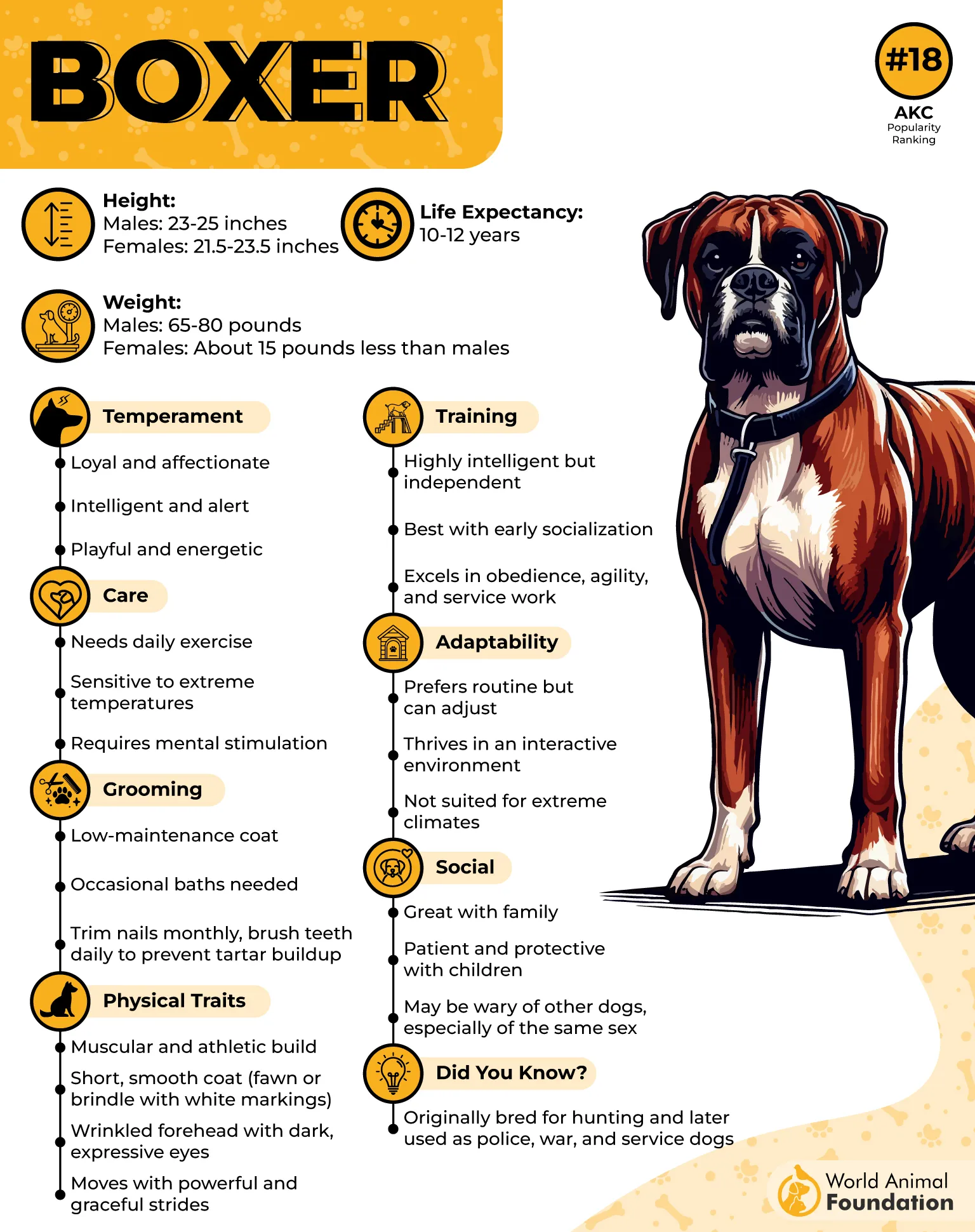
Originally bred in 19th-century Germany as bull baiters and cattle wranglers (yes, they literally helped control livestock in slaughterhouses), Boxers quickly evolved into one of the most versatile working breeds around.
Police dog? ✔️
Seeing-eye dog? ✔️
Loving, playful family clown with superhero-level kid instincts? ✔️✔️✔️
Despite their tough origins, Boxers are affectionate softies at heart. They’re known for forming tight bonds with their humans—especially children—and thrive on constant companionship, physical activity, and attention.
Boxer Breakdown:
Energy Level: High—comes with built-in springs
Guarding Instinct: Natural protector with playful delivery
Watch Out: Prone to destruction if bored or lonely
As per Hillspet, leave a Boxer alone too long, and they’ll turn into a one-dog demolition crew. Think of them like energetic toddlers in a muscle suit—they need something to do or they’ll create their own “projects.”
9. Giant Schnauzer
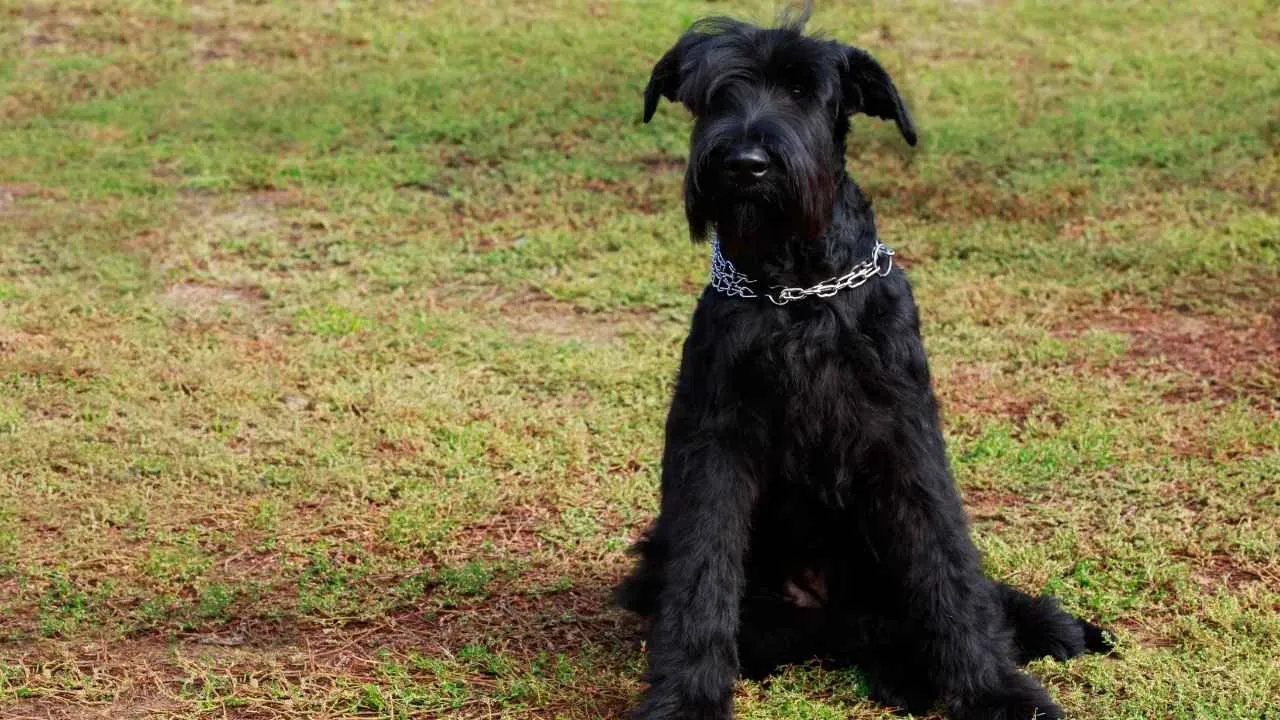
Breed Group: Working Group
Don’t let the fancy mustache fool you—this dog means business. The Giant Schnauzer looks like a wise old professor crossed with a bouncer at a VIP club.
Elegant and imposing, this working breed combines brains, brawn, and a boatload of loyalty in one fuzzy (and slightly intimidating) package.
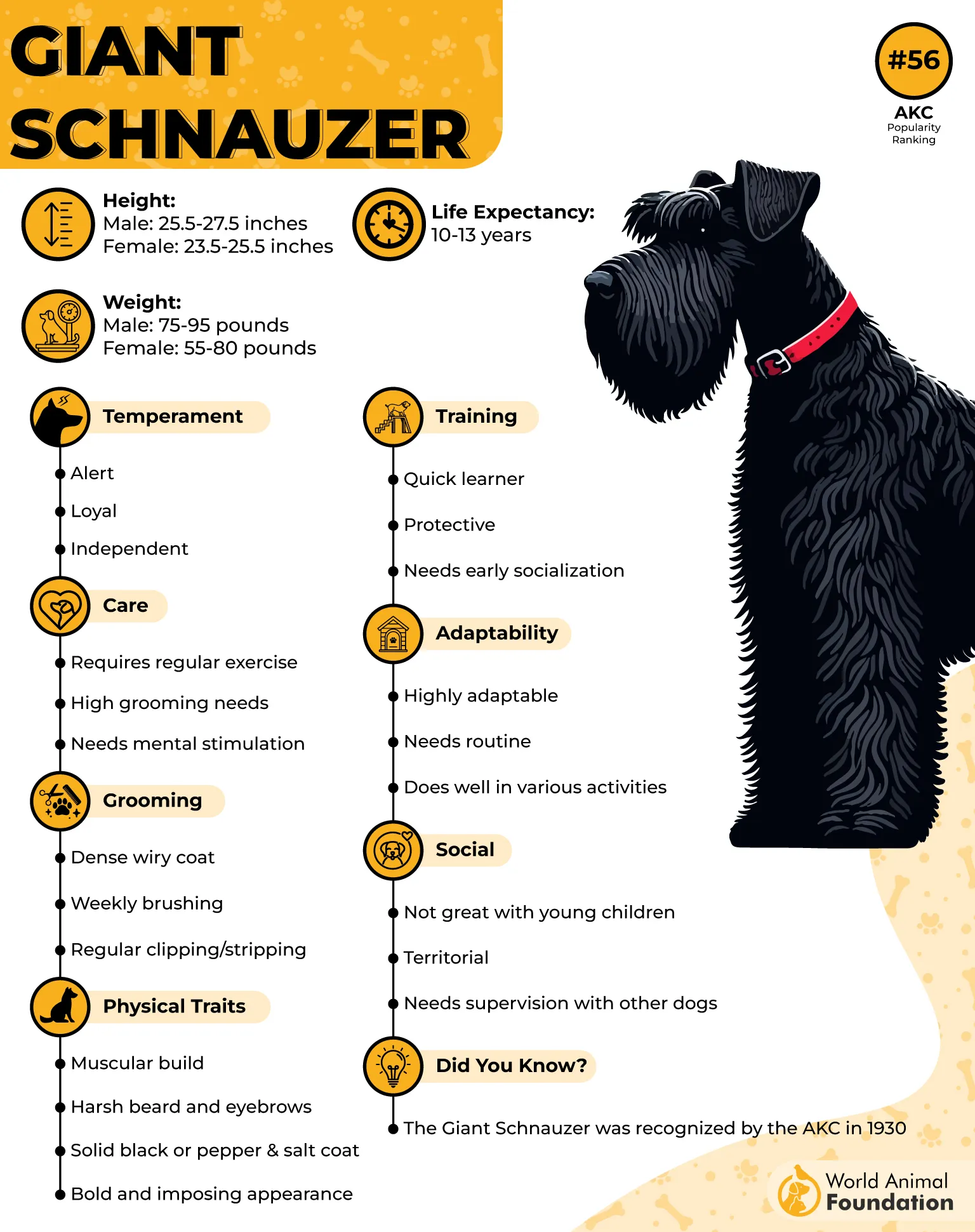
Towering over its smaller Schnauzer cousins, the Giant earned its name for a reason—these dogs are built like miniature draft horses, often mistaken for shaggy ponies by excited kids (who may or may not try to hop on). But let’s be clear: they’re guard dogs, not amusement rides!
Giant Schnauzer Snapshot:
Strength Level: Strong enough to tow your groceries home
Intelligence: Top-tier problem solver (they might outsmart you)
Ideal Home: Big yard, active family, and mentally enriching routines
Bred to drive cattle and protect property, Giant Schnauzers are serious about their job. They’re intelligent, intensely focused, and naturally suspicious of strangers—perfect traits for home security.
But with their family? Total goofballs. Affectionate, playful, and clownish when relaxed, they thrive on bonding time with their humans, as long as you also give them a job or puzzle to solve.
10. Boerboel
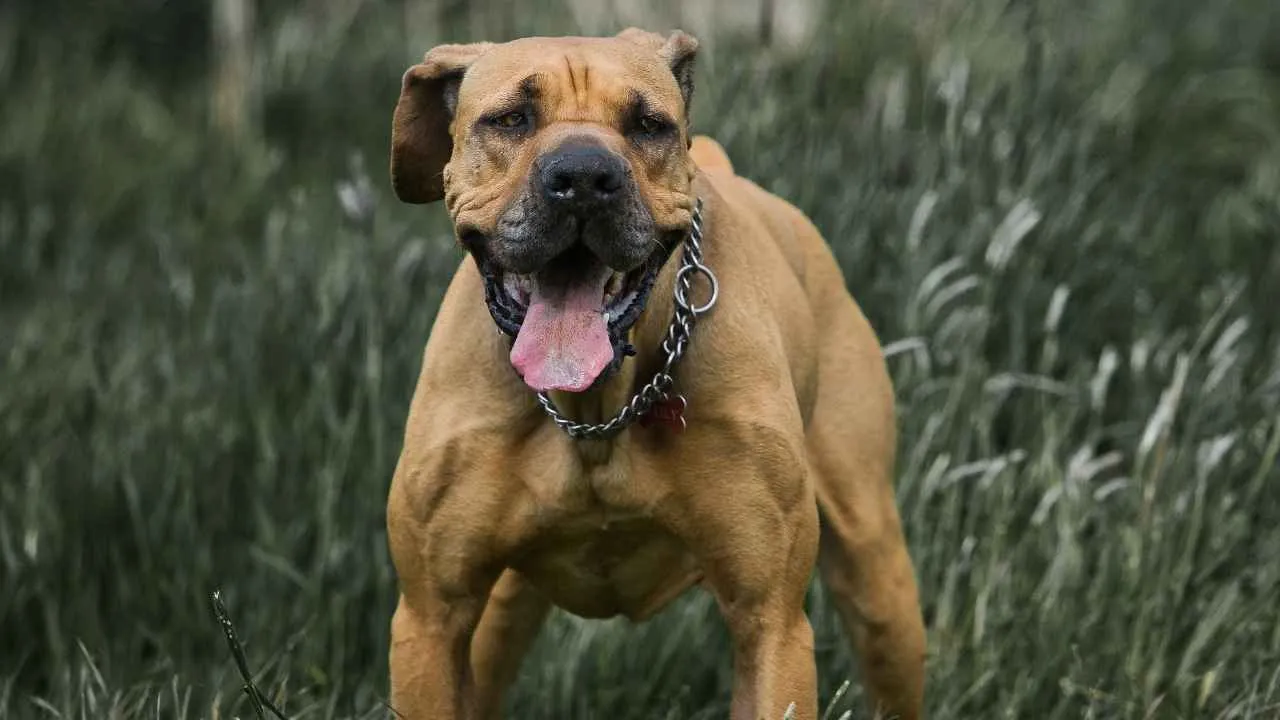
Breed Group: Working Group
Imagine if a tank had a heart. That’s the Boerboel. Hailing from South Africa and bred to guard homesteads from lions (yes, actual lions), this muscular powerhouse is the canine version of a bodyguard in a tux—tough on the outside, a total softie with their humans.
Boerboels are not just big—they’re massive, often tipping the scales at over 150 pounds of solid muscle and determination.
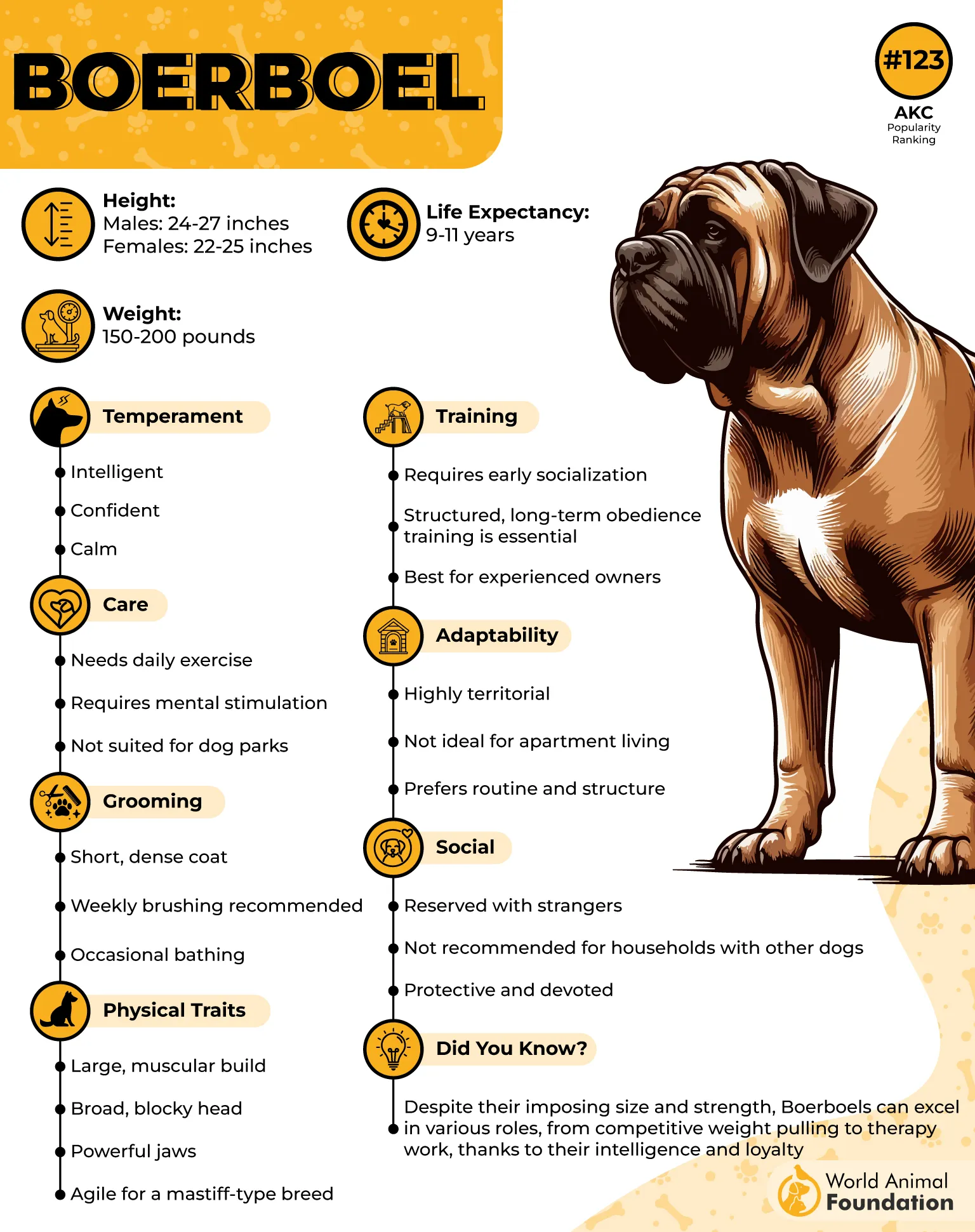
But don’t let their size intimidate you (okay, maybe a little)—beneath that robust exterior is a loyal, affectionate dog who bonds deeply with their family. They’re surprisingly gentle with kids and incredibly affectionate once they trust you.
That said, this isn’t a breed for the faint of heart—or the lazy trainer. Boerboels are highly intelligent, dominant, and know their worth.
Boerboel at a Glance:
Job Title: Personal Security with Extra Drool
Best With: Experienced owners, strong leadership, lots of space
Guard Level: Will patrol your yard like it’s Fort Knox
Without early, consistent training and firm boundaries, they’ll happily take over as household CEO (and we don’t mean “Canine Executive Officer”). First-time dog owners? You might want to swipe left on this one.
Conclusion
Other great guard dog breeds—such as the Tibetan Mastiff, Akita Inu, Great Dane, and Rhodesian Ridgeback—are known for their protective nature, imposing presence, and ability to deter intruders. These powerful dogs often serve in police and military roles, or guard livestock as gentle giants with thick, medium-length double coats. Their highly territorial instincts and loyalty help them form strong bonds with family members and alert owners to danger.
However, early training, early socialization, and positive reinforcement are essential from a young age to ensure the dog’s temperament remains stable, especially around other dogs, other animals, and family pets. To avoid health issues like hip dysplasia, always seek veterinary care and buy from reputable breeders. With the right guard dog, families can enjoy both protection and companionship.


